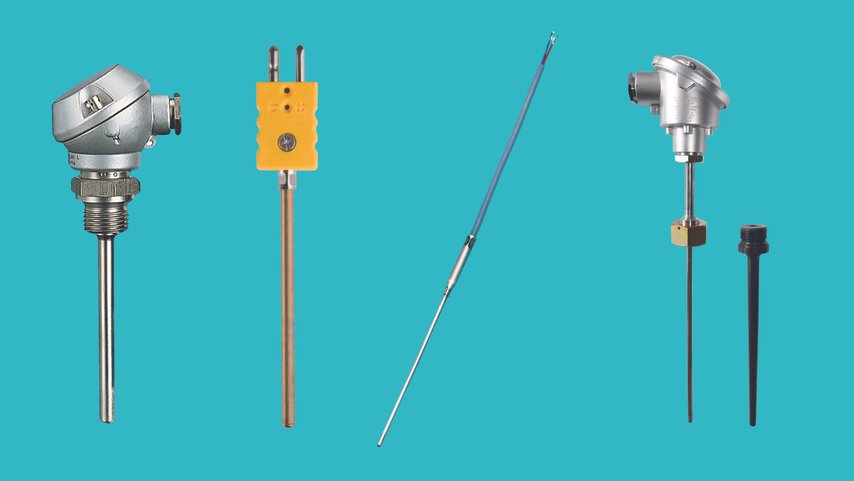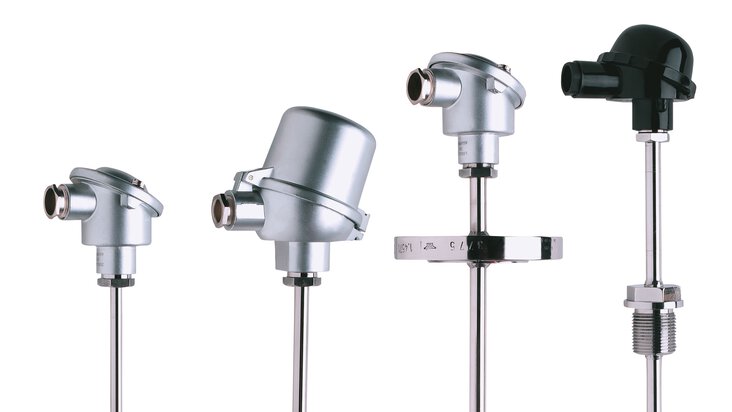

Sheathed thermocouple: characteristics, construction, application
Would you like to learn about the technology that is revolutionising temperature monitoring in the chemical, food, aerospace, energy and steel industries? Jacketed thermocouples are just the solution! Read on to understand how these extremely robust, flexible and precise devices can support your business by providing accurate temperature measurements even in the harshest environments.
Sheathed thermocouples - what are they?
A thermocouple is a thermoelectric sensor that consists of two semiconductors made of different materials and welded together at one end at a point called the measuring junction. Thermocouples sheathed thermocouples are distinguished than conventional thermocouples due to their smaller size and the fact that they can be bent freely (with a minimum bending radius), which makes them suitable for use in difficult-to-reach measuring locations. measuring points that are difficult to access.
In sheathed thermocouples, the thermal element is embedded in a hard and highly compressed ceramic powder. This acts as an electrical insulator and provides mechanical and chemical protection for the measuring junction. Depending on their material, they can even be used at temperatures in excess of 1500°C.

Type B sheathed temperature sensors (type 901006)
Sheathed thermocouple - construction
A sheathed thermocouple consists of:
- Thermocouple wires: Two wires made of different metals or alloys that are connected together at one end and generate a voltage in response to heat.
- Sheath: A metal sheath that protects the wires from harmful environmental influences and transfers heat to the wires.
- Insulation: A material that separates the wires from each other and from the sheath, preventing physical contact that could interfere with the measurement.
- Cold junction: The end of the thermocouple that is connected to the measuring device and serves as a reference point for temperature calculation.
Sheathed thermocouple sheath
Diameter of the thermocouple sheath determines its flexibility and its strength. It can range from 0.5 to 8.0
mm. A smaller diameter provides greater flexibility, which is advantageous in confined spaces, while a larger diameter increases the mechanical strength and resistance to vibration. When choosing the diameter of the thermocouple sheath, therefore, a trade-off must be made between these properties.
Material of the thermocouple sheath plays an important role in its resistance to high temperatures and corrosion. Sheathed sensors with a sheath made of Inconel 600, a Ni 2.4816 alloy, are corrosion-resistant and ideal for high temperatures. In addition, they are resistant to chlorides and ammonia. On the other hand, jacketed thermocouples made of stainless steel
316 stainless steel are resistant to aggressive agents and fumes.
The choice of the appropriate diameter and sheath material depends on the specific requirements of the application, such as corrosion resistance, mechanical strength or flexibility.

Type J, K, L or N thermocouple with flexible sheathed cable and compensation plug (type 901240)
Sheathed thermocouple - advantages
Let us briefly summarise what you have learned so far. Jacketed thermocouples are characterised by the following features:
- Embedding in powder ceramic: The thermocouples in sheathed thermocouples are embedded in a densely packed ceramic powder, which increases their strength and stability.
- Resistance to high temperatures: Can be used in environments with temperatures in excess of 1,000 °C, thanks to the use of suitable alloys for the conductor.
- Flexibility and thin construction: Due to their unique design, sheathed thermocouples can be very thin and flexible, allowing them to be used in hard-to-reach measurement locations. The diameter of sheathed thermocouples can be as small as 0.25 mm, regardless of size, without compromising the integrity of the instrument
- Moisture resistance: sheathed thermocouples are tightly welded, eliminating the possibility of moisture penetration and interfering with measurements.
- Shock resistance: The metal sheath and MI cable protect the leads from shock and vibration, preventing damage and making sheathed thermocouples extremely resistant to mechanical stress.
- Resistance to corrosion and aggressive substances. Stainless steel 316 has good resistance to aggressive chemicals and to vapours and fumes in chemical media. The corrosion resistance properties of Alloy 600 make it particularly suitable for thermocouples operating at high temperatures. It also resists cracking and pitting in chlorine-containing media, as well as corrosion caused by hydrogen chloride or ammonia in aqueous solutions.
- Rapid response to temperature changestemperatures.

Type K, J, L thermocouples with compensating cable (type 901250)
Sheathed temperature sensors - types
Mantle thermocouples come in many types to suit a variety of applications and operating conditions.
- Type J (Fe-CuNi) sheathed thermocouples are used in vacuum and oxidising, reducing and inert atmospheres. They are typically used to measure temperatures up to 750°C and, for models with the thickest conductor, up to 760°C, according to ASTM E230.
- Type K, or NiCr-NiAl thermocouple, is the most commonly used variant. Designed to operate in oxidising or inert atmospheres, it is capable of measuring temperatures up to 1,200 °C and even 1,260 °C for the models with the thickest conductors, according to ASTM E230.
- Type N (NiCrSi-NiSi) is dedicated to oxidising atmospheres, inert atmospheres or dry reducing atmospheres, with the ability to measure temperatures up to 1200 °C (ASTM E230: 1260 °C). This type demonstrates high accuracy in high-temperature measurements, with a temperature range and source voltage (SEM) almost identical to type K. It is used in applications requiring longer life and stability.
- Type E (NiCr-CuNi) is designed for oxidising atmospheres and inert atmospheres to measure temperatures up to 900 °C (ASTM E230: 870 °C) for models with the thickest conductors.
- Type T (Cu-CuNi), constructed for operation at sub-zero temperatures, is capable of measuring up to 350 °C (ASTM E230: 370 °C) and can be used in oxidising, reducing and inert atmospheres. It shows corrosion resistance in humid atmospheres.
- Thermocouples types R, S and B are also available in MI cable inserted versions. Detailed specifications for the temperature range, accuracy class and dimensions of these 'noble' sheathed thermocouples should be determined on an individual basis.
Applications for sheathed thermocouples
Due to their mechanical strength, flexibility and wide temperature range, sheathed sensors are used in industries requiring precise temperature monitoring. Sheathed thermocouples are part of a typical temperature measurement system. In the chemical industry, for example, they are used to controlling the temperature of processes that are crucial to the quality of the final product. In the food and beverage industry, sheathed thermocouples help to maintain the right conditions for storing and processing foodstuffs.
They are also indispensable in the aerospace industry, where accurate temperature measurements can be crucial to flight safety. Their resistance to vibration and thermal shock makes them ideal for such applications. In the energy and
metallurgy, sheathed thermocouples are used for temperature monitoring under extreme pressure and temperature conditions.

Sheathed temperature sensors are installed in production lines and machines where continuous temperature monitoring is required
Comparison of measuring points in sheathed thermocouples
W sheathed thermocouples there are two types of sensor tip design: with insulated and grounded measuring points. When we speak of insulated measuring points, it means that the measuring point has no direct connection with the outer sheath of the sensor (we call these measurement points ungrounded). This is the standard type of junction, used mainly in conductive media or when electrical isolation of the of the measuring circuit.
On the other hand, in structures with earthed measuring points, the measuring point is bonded to the outer sheath of the sensor. In the case of earthed measuring points, the response time is considerably shorter; however, they are more susceptible to signal interference.
Sheathed temperature sensors - a summary
Sheathed thermocouples, thanks to their unique design, provide highly precise temperature measurements in the harshest industrial environments. They are characterised by their insensitivity to temperature, mechanical resistance, shock resistance and flexibility, making them an indispensable tool in many industries. Sheathed thermocouples are most commonly used in
hardening furnaces and for annealing machine components.
Choosing the right type of sheathed thermocouple depends on the specific requirements of the application, including operating temperature, atmosphere, mechanical conditions and measurement accuracy requirements. It is also important to understand the difference between insulated and grounded, which affect the sensor's response time and its susceptibility to signal interference. This knowledge allows you to choose the optimum solution to meet all your technical requirements, ensuring precise and reliable temperature measurements.
Use jacketed thermocouple technology to improve the quality of your products, processes and services. Act today to provide yourself and your customers with the highest level of temperature control. Contact us and get the right temperature sensor!
- ${title}${badge}

